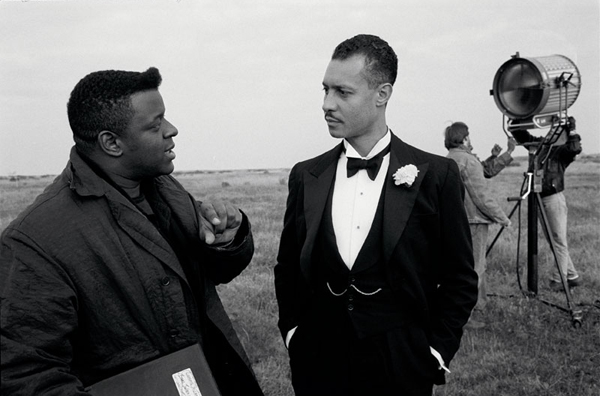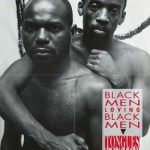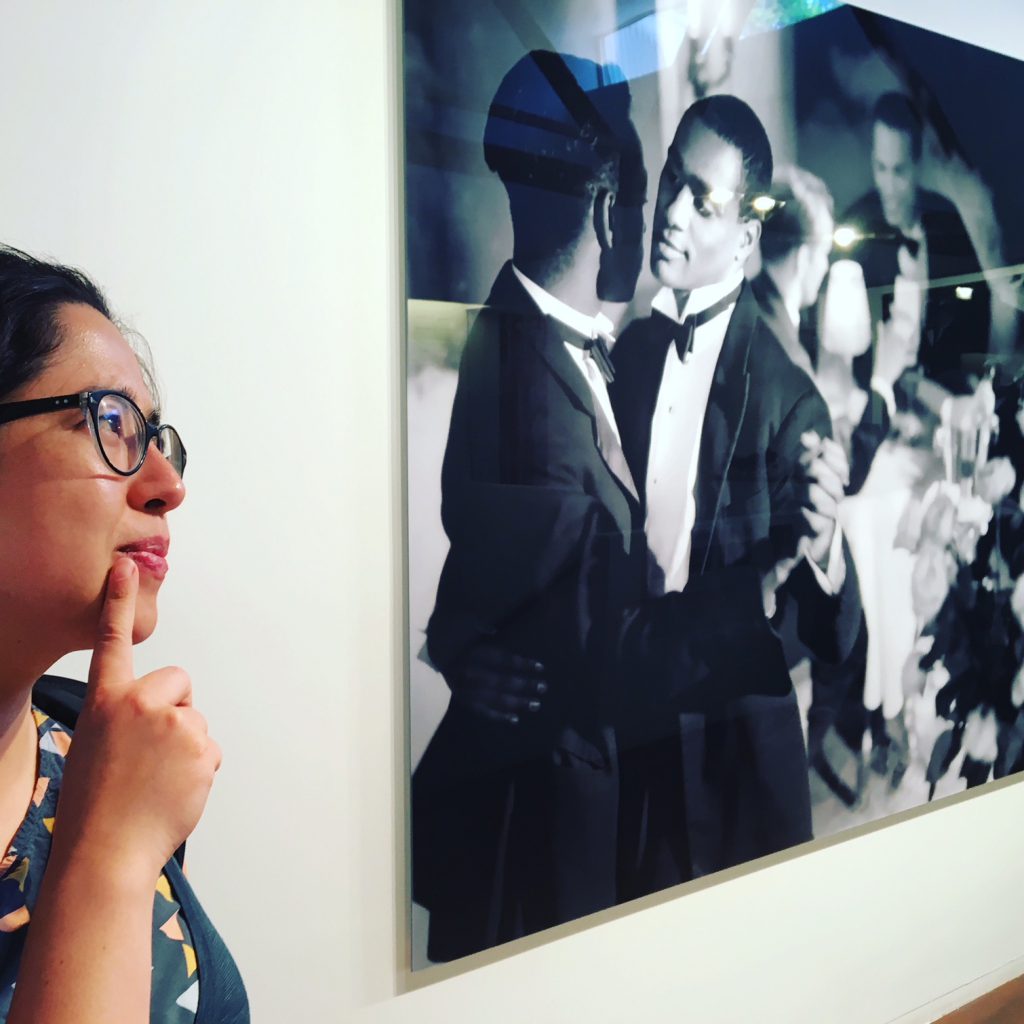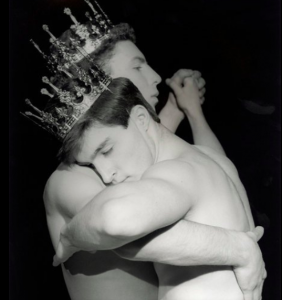On the face of it, nothing. There is nothing wrong with teaching a class where students experiment with ‘gendered’ movements. In fact, a class like that is very powerful and empowering, because it teaches us how gendered movement is constructed and learnt through the way we hold our bodies, the speed of our movements, how we occupy space, the way we hold our head, our gaze and eye line, etc etc etc.
I’ve seen a number of classes where this has been done very cleverly, and very well. Once Marie N’diaye was teaching a chorus line class at Herräng, where students were taken through the ways in which chorus lines in the 30s were gendered: how to emphasise your hips v your shoulders, how to turn your head, present a particular profile, focus on shapes or sizes of movements. I’ve also seen ‘girls’ hip hop’ classes taught by a man at a local street dance studio, where the students were taken through very femme movements and choreography employed by women dancers in music videos.
All of these classes make it clear (implicitly) that gender is something you can perform. That you can put on gender and take it off again, like a suit of clothes. And this idea of ‘performing gender’ is borrowed from Judith Butler’s book ‘Gender Trouble’. This is very important. Let me make it clearer: Butler (and other feminists and transpolitics writers) lay out very good cases for the idea that gender is something we _do_, not something we _are_. We learn to behave in ways which align with a particular gender role. This gender role is constructed by the culture in which we live. And the gender we choose is often chosen for us, by our families, our schools, our communities.
Right here and now, we can borrow from black feminists, who point out that there is no single way of being ‘female’ or ‘male’, and that these gender identities are culturally specific. So authors like bell hooks in We Real Cool point out how the dominant masculinity in modern American culture is _white_. It’s informed by race as well as gender. And then authors like Thomas Defrantz in Dancing Many Drums go further, pointing out how black masculinity isn’t just regulated by white ideas of what it is to be a man, but by heterocentric ideas of what a man should be.
In sum, gender is made.
Gender is not just about skin colour or the food you eat. It’s about class, it’s about sexuality, it’s about age, it’s about who we are and how we live every day.
And there are ‘dominant’ ideas of gender in different cultures. By dominant, I mean ‘most preferred’, or ‘seen most often’ or most favoured’. In some cultures there are more than two acceptable gender identities. But within western capitalist heterosexuality, there are only two. In this limited world, there is a dominant, hegemonic masculinity. This idea of ‘hegemonic masculinity’ is culturally specific. I like this term ‘hegemonic masculinity’ because it asks us to talk about class – capitalism – as well.
An ‘ideal masculine’ varies between cultures. If we’re talking about lindy hop, then, we need to allow for the fact that lindy hop today is a cross-cultural, international activity and community. There are different types of masculinity. Many cultures go another step further, and order different gender identities (or ways of being masculine or feminine) in hierarchies. Or, some ways of being a man or being a woman are considered ‘better’ than others.
So what is the ‘hegemonic masculinity’ at work in today’s lindy hop? The answer is going to be different, depending on which country and which city and which local community you’re considering. Let me start with Australia, because that is where I live. And let me start with white, mainstream culture. Here, hegemonic masculinity is:
- white (anglo-celtic, coloniser)
- heterosexual
- able-bodied
- economically affluent
Where did I get this list?
Well, if we have a look at a few things in my culture, we can find answers very quickly:
- The nation’s political leaders (prime minister, cabinet ministers, etc);
- The people with the most money (millionaires, industrialists, business owners);
- Religious leaders in the most popular religions (bishops, ministers);
- The most commonly-seen and employed actors and entertainment figures.
All of these people are male. And until very very recently, openly heterosexual (often ‘proved’ by having a wife and children), white, able-bodied. Rich. Coloniser.
You can do the same sort of exercise with the dance world. What are the most powerful roles in the modern lindy hop world? How many of these roles are filled by men, or filled by women? And what types of men and women fill these roles? How does your local scene compare with what you see in the videos and websites for huge international American, European, or Asian events? How does your national scene compare with these?
But what about women?
Hegemonic masculinity cannot exist without a dominant model for ‘femininity’. This ‘ideal woman’ is:
- white (anglo-celtic, coloniser)
- heterosexual
But she is dependent on a male partner, as she is also
- physically weak or vulnerable
- economically weak or dependant
- physically ‘attractive’
Her heterosexuality is proven by her ability to have children, and her physical appearance (her sexual appeal). This ‘appeal’ is again contextually dependent. In Australia, she is slim, long-legged, pale-skinned, long (straight) haired, has small feet and hands, clear skin, ample bosom (but not too ample), hips (but not too broad)… and so on.
In fact, her body is an impossible ideal. Women are trained to pursue this impossible ideal at the expense of all else. They are trained to spend more time on how their body looks, than on how it works. To spend more time thinking about what they look like, than on what they can do. They spend time in the gym working on their body’s appearance, rather than their body’s functionality.
If you pay attention, you can see how these physical characteristics are all racialised. She has pale skin. She has narrow hips and thin legs. She has straight hair. The small hands and feet and long legs can be achieved by the way she points her toes and extends her arms. She does not give us de kneebone bent, because that would be ‘inelegant’. That would be black.
From here this ideal femininity and masculinity can also be defined by how they behave, or how they act. Men are active, physically tough, powerful, defensive and offensive agents. They take up physical and aural space in public. Women are passive, acted upon, vulnerable, hurt, weak. They make themselves small and speak softly so they don’t take up space. These two models are used to justify the relationship between the ideal male and ideal female: the female requires a strong man to protect her. The strong man requires the vulnerable female to give him children (and incidentally prove he’s not gay :D ) and keep his home. The active, fierce man is complemented by the passive, emotional, gentle woman.
And so on.
All of the things I am writing here are old news to anyone who’s done any feminist reading. I myself have two theses and a bunch of articles drawing on extensive field work and textual analysis to prove these ideas. In fact, my doctoral thesis looked at how this stuff plays out in the lindy hop world.
Let’s go all the way back to that first question:
What is the problem with teaching ‘traditional’ gender roles in lindy hop?
Nothing. While some feminists would disagree with me, I don’t think there’s anything wrong with being vulnerable or small or pale or delicate. Or strong and bold and heterosexual. But I do think there’s a very big problem with a) these models being presented as the only ways of being a man or woman, b) with ‘man’ and ‘woman’ being the only options, and c) with these dichotomies (either-or options) being the most preferred models.
In lindy hop today, we see traditional white, heterosexual gender roles rewarded and valorised across cultures.
Take a look at the winning ‘couples’ at ILHC, the Savoy Cup, or any of the other big competition events. Who wears the dresses? How does each partner move independently, and in reference to their partner? What is their ethnicity? What angles and lines do their bodies make?
The competition finalists and winners are almost exclusively white, heterosexual-presenting, and adhere to these very conventional gender roles. We can make occasional exceptions, we might even see one same-sex couple. There may be a few women wearing trousers. But taken as a whole the repeating, and therefore dominant elements do nothing to reconstruct or challenge the gender norms. We never see women leads in winning couples. We never see men as winning follows. In fact, we rarely see a deviation from this gender binary: man/woman. How dull. How dangerous.
What’s the problem with this?
If these winners align with the dominant values of their community, is there anything particularly wrong with this?
This is where things get really interesting.
What exactly is the problem with these two gender roles?
These two roles encourage particular types of behaviour. That’s a very general comment, so let’s get specific. I’m going to take an issue that’s very important: safety.
How do these roles contribute to sexual assault and harassment in the modern lindy hop world?
I’m going to assume that you agree with me that sa and sh are bad things. Remember, this isn’t a universal belief. There are plenty of people who don’t believe that sh and sa are actual real things. I believe that they are. I believe that they are bad, not only for the people involved, but also for the community as a whole.
sa and sh physically hurt people, but they also discourage women from entering high profile or well paid roles (DJing, teaching, MCing, organising). This means that sh and sa limit the way our communities grow and do things. It makes us ordinary.
Let’s take that dominant feminine identity and apply her to lindy hop.
- The follow role is associated with the feminine
We only have women or femme folk teach as follows at big events, we see workshops in ‘feminine styling for follows’ (but rarely other gendered options). - Follows are ‘quieter’
She doesn’t initiate moves or outshine the lead. She doesn’t interrupt or speak louder than the lead in class. - Follows are objects that things happen to
She doesn’t turn or spin; she is spun. She doesn’t decide where to move; she is moved. She doesn’t choose moves; the moves are chosen for her. She isn’t an equal partner; she makes the lead’s moves ‘work’. - Follows ‘look beautiful’ – they have long legs, small hands and feet, a slim build (with bosom, but not too much), they have pale skin, they have long straight hair
She wears clothes that exaggerate these elements – dresses and skirts, form fitting trousers, high heels (to make her legs seem longer and her feet smaller), make up. She dances in ways that exaggerate these elements – she points her toes and straightens her legs and arms, she extends her neck and drops her shoulders, she opens her arms with the palms up and open.
SHE IS WHITE. SHE HAS STRAIGHT HAIR. SHE HAS PALE SKIN. SHE HAS A SMALL ARSE AND THIN THIGHS. SHE HAS SMALL MUSCLES, NOT BIG, STRONG MUSCULATURE. - Follows are helpful, polite, and unaggressive
She does as she’s led, she doesn’t abort moves. She spins as many times as the lead wants. She turns in the direction the lead wants. She doesn’t interrupt the lead’s moves, or distract from him. She is passive and helpful. She does not solo dance alone. She looks at the lead all the time. She does not say no to dances. She does not stop dances mid-way. She doesn’t tell men to stop hurting or touching her. She will compromise her rhythm or timing for the sake of the lead’s rhythm or timing. - Follows are vulnerable; things happen to them, which they need to be protected from
She is vulnerable to kicks and accidents on the dance floor, and has to be protected by her lead. She is vulnerable to sh on the dance floor, so she needs a man to protect her. She doesn’t say no to dances. She must be walked to her car. - The follow is dependent on a (male) lead
She doesn’t say no to a dance; she cannot solo dance (she’s too afraid, she doesn’t know what to do). She cannot dance with a woman; only men can/are lead properly. Dancing with a woman would make people think she was a lesbian. She gains her worth from her heterosexual relationship with a man. She doesn’t tell a harasser to STOP; she reports him to a (male) organiser.
And so on and so on.
But remember: you cannot have this ideal femininity without an ideal masculine, and vice versa. Because in this story, the ideal fem or masc is heterosexual. Without a man, a woman is a lesbian (or a failure). Without a woman, a man is gay (or a failure).
We can do the same exercise with men and this ideal masculinity.
Can you do that? I’m a bit tired of typing, so I’ll leave you to make a little list. Write it down. What are the ways ‘leading’ is gendered hegemonic ‘masculine’?
These are all things that happen on the dance floor. But the modern lindy hop culture encourages us to see dance floor behaviour as the ideal model for off-floor behaviour. The most influential and powerful people at events are teachers and competition winners – people valued for their dance skills.
What happens when we extend this idea that a woman never says no to an invitation to dance? She is, in effect, told that she cannot say no to a man wanting to touch her. That she should smile and facilitate all the things that he wants to do to her body.
I wish that I could dismiss this as an exaggeration. But if we keep in mind the whole rest of the culture in which lindy hop is embedded, then we see that it’s not only unlikely, it’s also very difficult for a woman to say ‘NO’ to a man’s desire to touch her body. On and off the dance floor.
Here, look: this is how a dominant gender model informs lindy hop culture, and how this gendered dancing enables sexual assault and harassment.
Let’s go back a step.
Because I can’t stop there. I can’t stop at this feminist analysis. I need to do some feminist activism as well. I need to do and say something that will make it possible for me to go to lindy hop events. Make it possible for me to dance.
What are the problems?
1. We are using only white, middle class, mainstream Australian culture as a source for gender identities.
2. We haven’t considered this dance in historical context. What was happening in terms of gender in the 1920s and 30s?
3. We haven’t considered this dance in historical cultural context. What was happening in terms of black gender in the 1920s and 30s?
4. We haven’t considered this dance in contemporary cultural context. What is happening in terms of black/Asian/poc gender in Australia today? What is happening in terms of black gender in America today?
There are ways we can rethink gender in lindy hop: by actually watching and listening to black dancers.
In other words: thinking intersectionally about lindy hop (decolonising lindy hop; taking it out of white hands) will help us prevent sexual assault and harassment. I’m saying it clearly: there’s a problem with white, middle class, mainstream masculinity and femininity. And it has done bad things to lindy hop. Bad things to black lindy hoppers as well as white.
So, as a white women, I need to get my learn on.
For me, the first thing I have to do is sit down and listen. Stop talking. I need to watch and see what black dancers are already doing. I don’t ask them to come and give a lecture or wait at my beck and call in a dance class. I look at their work now.
——————————
INTERRUPTION-DISRUPTION
——————————
женщина & Sistas (an article on gender and following) – Grey Armstrong March 20, 2017
——————————
/INTERRUPTION-DISRUPTION
——————————
Let’s look at those examples I listed above, where we had men dancing the ‘femme’ role. Let’s look at vogueing. Here, at first glance, we have ‘men’ performing that dominant femininity. But that sentence doesn’t go anywhere near explaining all the things that are happening. For a start, the categories of ‘man’ and ‘woman’ and ‘female’ and ‘masculinity’ seem awfully limited.
Who are these people dancing? Would they describe themselves as men? As women? As trans? As nonbinary (enby – N.B.)? As soon as we ask these questions, and we ask these people these questions, we get a sudden explosion of gender and identity. I like to imagine that a black and white binary drawing (man/woman, male/female, strong/weak, good/bad) just opens up in a massive rainbow spectrum of colour and identity. Strength, weakness, power, vulnerability, creativity, gentleness, violence, beauty, ugliness.
Right here, we see a whole range of ways to do femininity or masculinity. Lots of different ways to be a man or a woman. Or to be a person that doesn’t want to fit into this binary.
Queer studies gives us lots of ways of to think about gender and human relations.
Let’s go back again. Remember where I mentioned Tommy Defrantz? Where I talked about the kneebone bent?
Defrantz is a queer black dancer, whose book looks at black dance history in America and asks ‘where is the queer black masculinity here?’ He himself offers us a very different way of moving his body:
Dood is extremely gay. He is so gay. He is the gayest. And he’s out. And he’s black. And he’s political. He’s also a dancer. A street dancer. A concert dancer. An academic. A thinker. An activist. He is all these things at once, AND he’s a man. This is a different way of embodying masculinity. Look at him while speaks the language of tertiary academia, the academy, territory of white masculine power.
But listen to his higher pitched voice. Look at the way he holds his hands close to his body, taking up less space. The way he shifts from foot to foot, implying uncertainty or a lack-of-obstinant-determination. Then watch all that change as he STAMPS into the ground with the buck dances. The way he embodies this role of the ‘buck‘: aggressive, fierce, determined, sexualised, large. And then he shifts again, demonstrating the wing dances, which he morphs until THERE! we see vogueing, and the ballrooms of 1980s queer black Harlem.
In this single two minute clip Defrantz takes us through a hundred years of black dance and black masculinity. He shows us how rhythm can be style. He shows us how rhythm can be black masculinity. And because he can then take it off again, he shows us – all of us, whatever our gender – that this masculinity can be put on and taken off at will! Imagine a black woman putting on that identity for a moment. Buck dancing!
But what if we actually look at a black woman dancing lindy hop. First ‘vanilla’, then ‘with sauce’. Here, Cookie (Angela Andrew) shows us how to dance as a follow, as a woman, as a black woman. Her skin is black. Her hair is up in a turban. She wears loose trousers and shirt. She addresses the camera. She is with her partner, but she is also taking creative space, saying I AM HERE with her clarity of rhythm. HERE I take a triple step and make it a stomp off. HERE I pause, I stop moving, I hold the time in my body and groove it on down. And HERE I suggest a rhythm to my partner, and because he listens to me, because he is open to my contributions, he takes it up and he joins me. We are together in this moment as equals.
It’s exciting. It’s very exciting.
——————————
INTERRUPTION-DISRUPTION
——————————
Black Culture a Lesson in Formality – Grey Armstrong – January 25, 2019
——————————
/INTERRUPTION-DISRUPTION
——————————
And what is the next step?
I actively choose not to hire teachers who run workshops which prioritise gender norms, or who exploit those gender norms. That means that I don’t hire teachers who’ve been reported for sexual assault or harassment. I don’t hire their friends who’ve stood by them and not called them up on their behaviour.
I do not hire teachers who’ve done publicly racist or antisemitic things. Nor do I hire their friends who’ve stood by them and not called them out on their behaviour.
Instead
I hire dancers of colour. I pay them good cashmoney for their work. I choose to hire teachers who are either actively engaging with gender, in a critical way, or I choose to hire teachers who are implicitly engaging with gender in an active way. Simply through being and dancing gender in different ways. This means that I can hire white teachers who talk the talk and attempt to walk the walk, and I can can hire dancers of colour who are teaching me about being gender simply by dancing-while-black.
More importantly, I can take their classes. Yes, that means you, dancer who thinks they’re too good to take classes any more. Be humble. Show you are willing to learn from this person of colour. Say, with your open face and willingness ‘I value what you have to teach.’ Be present in that class, be mindful. Learn. Assume that you don’t know how this works. Learn. Be open. Learn.
I think this is important: it’s not ok for me to ask teachers or dancers to articulate exactly what they are doing that makes them ‘black’. It is my job to learn to see how ethnicity informs who we are and how we move. It is my job, as a white woman, to stop seeing ‘whiteness’ as a default ‘norm’. It is my job to take my assumptions about what ‘good lindy hop’ is, and to see how my own privilege as a white women has shaped this set of values. All of this jargon – frame, connection, musicality, tone, leading, following – all of it is language circulated and controlled by white teachers, and commodified in formal dance classes. It is, truly, the colonisation of black dance.
It is my job to learn how to learn in new ways. To learn how to be in a class with a teacher and see how their movements, their ways of holding their bodies, of taking, of looking at students and each other, of being inform their dancing. Whether they are black or white, hispanic or asian. If dance is culture, then I need to do more than just ‘have a class with a black teacher’. I need to learn how my entire understanding of dance and classes is informed by my own ethnicity.
Here is a list of people you may choose to hire, who are not skinny white heterosexual women and men. Some of them are lindy hoppers, some tap dancers, some do dances traditional to their peeps, some are musicians. I haven’t even really gotten into Asia with this list, and it is totally not exhaustive.
And please note: being the old black/queer/asian in the village can be tiring and intimidating. Why not hire two! Or three! Or ALL of them!
- Angela ‘Cookie’ Andrew
- Dee Daniels Locke
- Josh McLean
- Fatima Teffahi
- Sing Lim
- Kieran Yee
- Katharina Duarte
- Nick Davis
- Javier Johnson
- Nika Jin
- Tricia Sewell
- LaTasha Barnes
- Shana Maria Weaver
- Anaïs Sékiné
- Marie N’diaye
- Helena Martins
- Damon Stone
- Josette Wiggan-Freund
- Joseph Wiggan
- Usman Camara
- Ursula Hicks
- Corina Kwami
- Maria Schilling
- Kevin Harris
- Denise Minns Harris
- Andrew Hsi
- Paulo Inacio Pereira Pereira
- Chester Whitmore
- Remy Kouakou Kouame
- Tamisha Anthony









